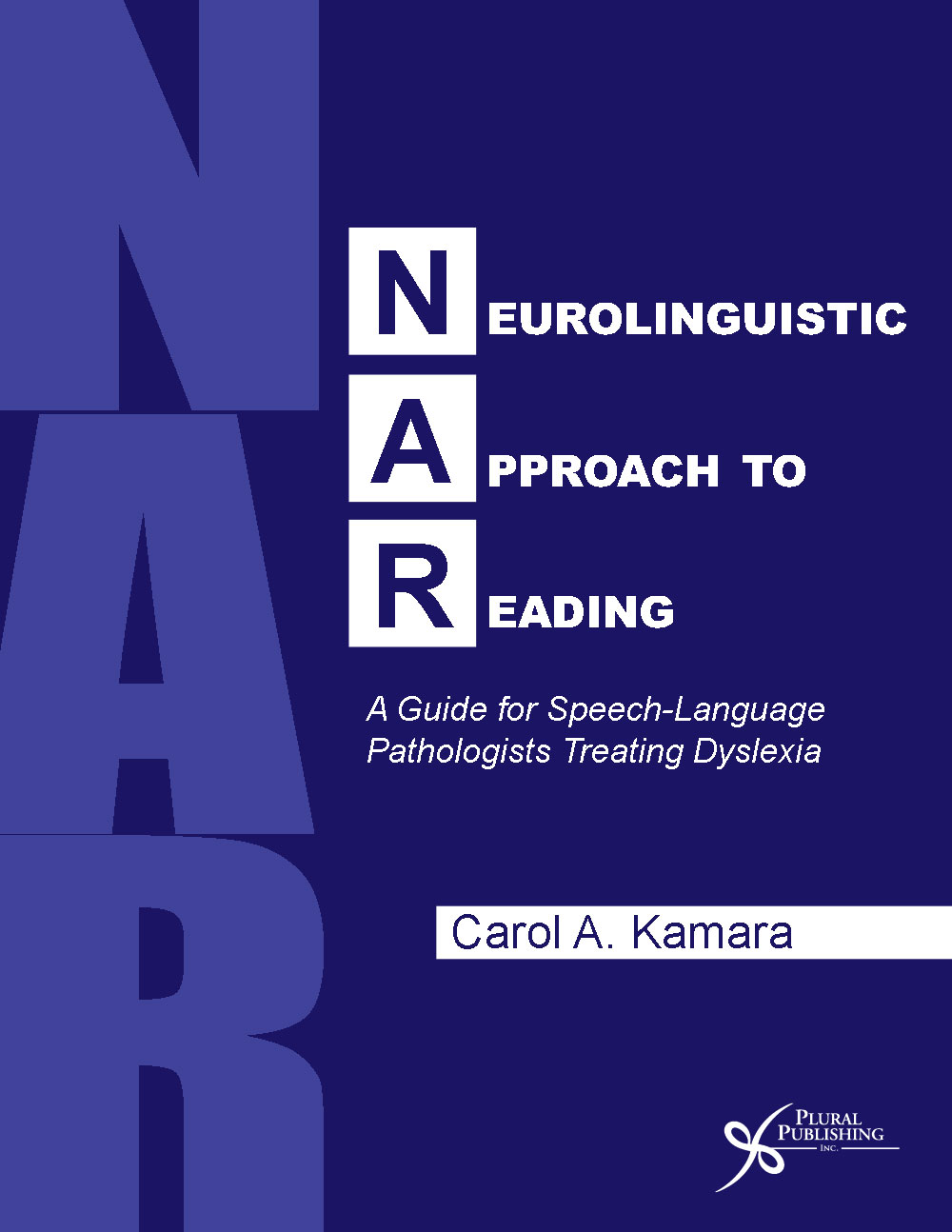
Neurolinguistic Approach to Reading: A Guide for Speech-Language Pathologists Treating Dyslexia
First Edition
Carol A. Kamara
Details: 320 pages, B&W, Softcover, 8.5" x 11"
ISBN13: 978-1-59756-655-1
© 2015 | Available
Purchase
Neurolinguistic Approach to Reading: A Guide for Speech-Language Pathologists Treating Dyslexia aids speech-language pathologists (SLPs) in assessing and treating dyslexia through an approach proven effective by national standardized tests, subjective evaluation, parents, teachers, as well as those in the field.
The author developed the Neurolinguistic Approach to Reading (NAR) based on more than 25 years of experience working with individuals with dyslexia. This inclusive approach is based on the complete communication process, oral and written. The text also includes the Cornell note-taking system and can be used as an effective clinical manual or a university reference.
This text comes at a crucial time as the scope of practice for speech-language pathology has greatly expanded with the increased recognition of the direct relationship between oral language and a child's ability to read and spell. Additionally, the American Speech-Language-Hearing Association has defined the SLP's role in the remediation of literacy disabilities such as dyslexia.
Through this effective text and utilizing NAR as a treatment framework, SLPs in all work environments can be more involved in working with individuals with dyslexia.
Appendices Include
Appendix A. Alphabet Charts
Appendix B. Consonant and Vowel Distinctive Feature Charts
Appendix C. Stage II Activities
Appendix D. Phoneme Deletion Exercises
Appendix E. NAR Spelling Forms
Appendix F. Miscue Analysis
Appendix G. Sample Charts, Sentences, and Stories From NAR Lists
Appendix H. “Rules” for Double Consonants
Appendix I. Diagrams
Appendix J. Grade-Level Spelling Sets
Chapter 1. Provider and Recipient of NAR
- Qualifications of the Speech-Language Pathologist
- Dyslexia
- The Gifts of Dyslexia
- The Client Who Would Benefit From NAR
- Early Identification
- Assessment
- Central Auditory Processing Disorder (CAPD)
Chapter 2. Rationale for Approach
- Neurolinguistics: The Neurobiology of Language
- Language: Listening=>Talking=>Reading=>Writing
- Reading and Writing as an Overlain Process
- The Listening Environment
- Brain Plasticity
- Zone of Proximal Development (ZPD)
- Brain Training
Chapter 3. Measuring Outcome
- Evidence-Based Practice
- Outcomes of Phonology Focus in Early Years
- NAR Outcomes
Chapter 4. Other Spelling/Reading Programs
- Phonics Versus Whole Language
- Lindamood
- Phono-Graphix
- Phonics
Chapter 5. Overview of NAR
- Four Stages of NAR
- Stage I: The Alphabet
- Stage II: The Mouth
- Stage III: Nonletter Spelling (Color Coding)
- Stage IV: Letter Spelling
- Adults
Chapter 6. Detailed Description of Stage I: Alphabet Knowledge
Chapter 7. Detailed Description of Stage II: Mouth-Ear Phoneme Perception Training
- Distinctive Features
- The International Phonetic Alphabet (IPA)
- Consonant Distinctive Features
- Front (Anterior)
- Labial (Lips)
- Voiced (Loud, noisy, vibrated)
- Dental (Teeth)
- Plosive (Exploding, stopping, popping)
- Sibilant (Hissing, snake, sharp, strident)
- Fricative (Scraping, sanding, buzzing)
- Nasal (Nose, honking)
- Glide (Sliding, moving, joining)
- Vowel Phoneme Distinctive Features
- Lip Rounding Versus Spreading
- High Versus Low Tongue Height
- Open and Closed Vowels
- Front Versus Back Vowels
Chapter 8. Detailed Description of Stage III: Coding Phoneme Patterns With Colored Objects
- Color Coding Phoneme Strings
Chapter 9. Detailed Description of Stage IV: Spelling Sounds With Letters
Chapter 10. Special Considerations
- Pronunciation Peculiarities
- Dealing with the Schwa
- Merger of Phonology and Syntax Rules
- Regular Past-Tense Pronunciation of /-ed/
- Plural, Possessive, and Third-Person Singular Word Endings
- Plural Noun Endings
- Plural Words Ending in /y/ and /ey/
- Plural Words Ending in /f/
- Plural Words Ending in /o/
- Root Word Changes for Plural Nouns and Nouns Used Only in Plural
- Zero Plural Nouns
- Possessive Designation of Zero Plural Nouns
- Possessive Designation of Regular Plural Nouns
- Pronunciation of Third Person Singular Verb
Chapter 11. Logistics
- Using the Block-by-Block Spelling Charts
- The Grade-Level Spelling Lists in Appendix J
Chapter 12. Summary
Appendix A. Alphabet Charts
Appendix B. Consonant and Vowel Distinctive Feature Charts
Appendix C. Stage II Activities
Appendix D. Phoneme Deletion Exercises
- Common Discrimination Errors
- Discrimination of Glides
- Discrimination of Nasals
Appendix E. NAR Spelling Forms
Appendix F. Miscue Analysis
Appendix G. Sample Charts, Sentences, and Stories From NAR Lists
- Sample Charts, Sentences, and Stories
- Sample Charts, Sentences, and Stories from NAR Lists
Appendix H. “Rules” for Double Consonants
Appendix I. Diagrams
Appendix J. Grade-Level Spelling Sets

